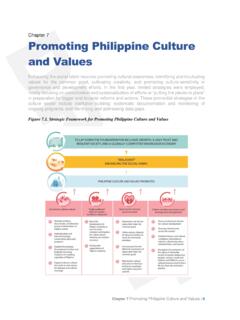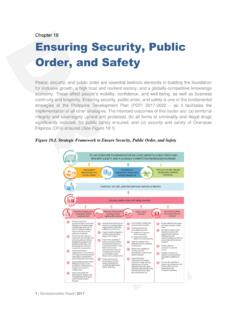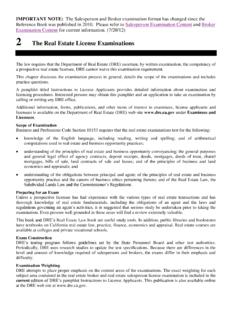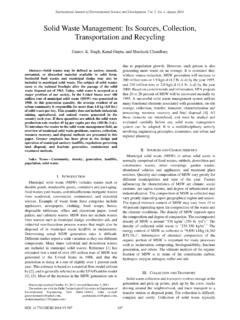Transcription of REPUBLIC ACT NO. 9136
1 REPUBLIC ACT NO. 9136 AN ACT ORDAINING REFORMS IN THE ELECTRIC POWER INDUSTRY, AMENDING FOR THE PURPOSE CERTAIN LAWS AND FOR OTHER PURPOSES Be it enacted by the Senate and House of Representatives of the Philippines in Congress assembled: CHAPTER I TITLE AND DECLARATION OF POLICY SECTION 1. Short Title. This Act shall be known as the Electric Power Industry Reform Act of 2001 . It shall hereinafter be referred to as the Act. SECTION 2. Declaration of Policy. It is hereby declared the policy of the State: (a) To ensure and accelerate the total electrification of the country; (b) To ensure the quality, reliability, security and affordability of the supply of electric power; (c) To ensure transparent and reasonable prices of electricity in a regime of free and fair competition and full public accountability to achieve greater operational and economic efficiency and enhance the competitiveness of Philippine products in the global market; (d) To enhance the inflow of private capital and broaden the ownership base of the power generation, transmission and distribution sectors.
2 (e) To ensure fair and non-discriminatory treatment of public and private sector entities in the process of restructuring the electric power industry; (f) To protect the public interest as it is affected by the rates and services of electric utilities and other providers of electric power; (g) To assure socially and environmentally compatible energy sources and infrastructure; (h) To promote the utilization of indigenous and new and renewable energy resources in power generation in order to reduce dependence on imported energy; (i) To provide for an orderly and transparent privatization of the assets and liabilities of the National Power Corporation (NPC); (j) To establish a strong and purely independent regulatory body and system to ensure consumer protection and enhance the competitive operation of the electricity market; and (k) To encourage the efficient use of energy and other modalities of demand side management.
3 SEC. 3. Scope. This Act shall provide a framework for the restructuring of the electric power industry, including the privatization of the assets of NPC, the transition to the desired competitive structure, and the definition of the responsibilities of the various government agencies and private entities. SEC. 4. Definition of Terms. (a) Aggregator refers to a person or entity, engaged in consolidating electric power demand of end-users in the contestable market, for the purpose of purchasing and reselling electricity on a group basis; (b) Ancillary Services refer to those services that are necessary to support the transmission of capacity and energy from resources to loads while maintaining reliable operation of the transmission system in accordance with good utility practice and the Grid code to be adopted in accordance with this Act.
4 (c) Captive Market refers to electricity end-users who do not have the choice of a supplier of electricity, as may be determined by the Energy Regulatory Commission (ERC) in accordance with this Act; (d) Central Dispatch refers to the process of issuing direct instructions to electric power industry participants by the grid operator to achieve the economic operation and maintenance of quality, stability, reliability and security of the transmission system; (e) Co-Generation Facility refers to a facility which produces electrical an/or mechanical energy and forms of useful thermal energy such as heat or steam which are used for industrial commercial heating or cooling purposes through the sequential use of energy; (f) Commission refers to the decision-making body of the ERC composed of a Chairman and four (4) members as provided under Section 38 hereof; (g) Concession Contract refers to the award by the government to a qualified private entity of the responsibility for financing, operating, expanding, maintaining and managing specific Government-owned assets.
5 (h) Contestable Market refers to the electricity end-users who have a choice of a supplier of electricity, as may be determined by the ERC in accordance with this Act; (i) Customer Service Charge refers to the component in the retail rate intended for the cost recovery of customer-related services including, but not limited to, meter reading, billing administration and collection; (j) Demand Side Management refers to measures undertaken by distribution utilities to encourage end-users in the proper management of their load to achieve efficiency in the utilization of fixed infrastructures in the system; (k) Department of Energy or DOE refers to the government agency created pursuant to REPUBLIC Act No.
6 7638 whose expanded functions are provided herein; (l) Department of Finance or DOF refers to the government agency created pursuant to Executive Order No. 127; (m) Distribution Code refers to a compilation of rules and regulations governing electric utilities in the operation and maintenance of their distribution systems which includes, among others, the standards for service and performance, and defines and establishes the relationship of the distribution systems with the facilities or installations of the parties connected thereto; (n) Distribution of Electricity refers to the conveyance of electric power by a distribution utility through its distribution system pursuant to the provisions of this Act.
7 (o) Distribution System refers to the system of wires and associated facilities belonging to a franchised distribution utility extending between the delivery points on the transmission or subtransmission system or generator connection and the point of connection to the premises of the end-user; (p) Distribution Wheeling Charge refers to the cost or charge regulated by the ERC for the use of a distribution system and/or the availment of related services; (q) Distribution Utility refers to any electric cooperative, private corporation, government-owned utility or existing local government unit which has an exclusive franchise to operate a distribution system in accordance with this Act; (r) Electric cooperative refers to a distribution utility organized pursuant to Presidential Decree No.
8 269, as amended, or as otherwise provided in this Act; (s) Electric Power Industry Participant refers to any person or entity engaged in the generation, transmission, distribution or supply of electricity; (t) End-user refers to any person or entity requiring the supply and delivery of electricity for its own use; (u) Energy Regulatory Board or ERB refers to the independent, quasi-judicial regulatory body created under Executive Order No. 172, as amended; (v) Energy Regulatory Commission or ERC refers to the regulatory agency created herein; (w) Franchise Area refers to a geographical area exclusively assigned or granted to a distribution utility for distribution of electricity; (x) Generation Company refers to any person or entity authorized by the ERC to operate facilities used in the generation of electricity; (y) Generation of Electricity refers to the production of electricity by a generation company or a co-generation facility pursuant to the provisions of this Act.
9 (z) Grid refers to the high voltage backbone system of interconnected transmission lines, substations and related facilities; (aa) Grid Code refers to the set of rules and regulations governing the safe and reliable operation, maintenance and development of the high voltage backbone transmission system and its related facilities; (bb) Independent Power Producer or IPP refers to an existing power generating entity which is not owned by NPC; (cc) Inter-Class Cross Subsidy refers to an amount charged by distribution utilities to industrial and commercial end-users as well as to other subsidizing customer sectors in order to reduce electricity rates of other customer sectors such as the residential end-users, hospitals, and streetlights; (dd) Inter-Regional Grid Cross Subsidy refers to an amount embedded in the electricity rates of NPC charged to its customers located in a viable regional grid in order to reduce the electricity rates in a less viable regional grid.
10 (ee) Intra- Regional Grid Cross Subsidy refers to an amount embedded in the electricity rates of NPC charged to distribution utilities and non-utilities with higher load factor and/or delivery voltage in order to reduce the electricity rates charged to distribution utilities with lower load factor and/or delivery voltage located in the same regional grid; (ff) IPP Administrator refers to qualified independent entities appointed by PSALM Corporation who shall administer, conserve and manage the contracted energy output of NPC IPP contracts; (gg) Isolated Distribution System refers to the backbone system of wires and associated facilities not directly connected to the national transmission system; (hh) Lifeline Rate refers to the subsidized rate given to low-income captive market end-users who cannot afford to pay at full cost; (ii) National Electrification Administration or NEA refers to the government agency created under Presidential Decree No.







